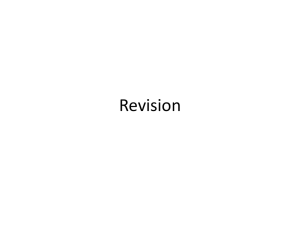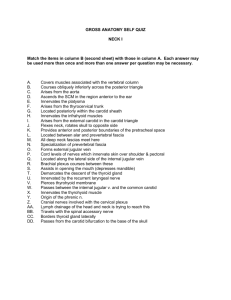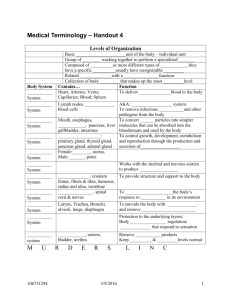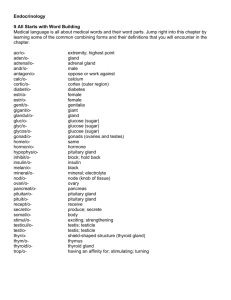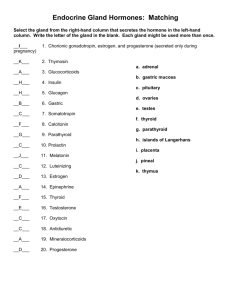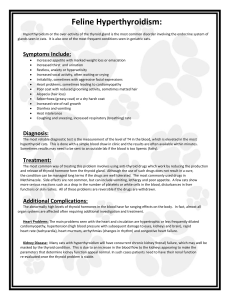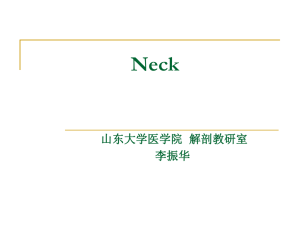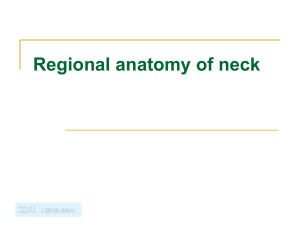Lobes of thyroid gland and carotid sheath (with its contents).
advertisement
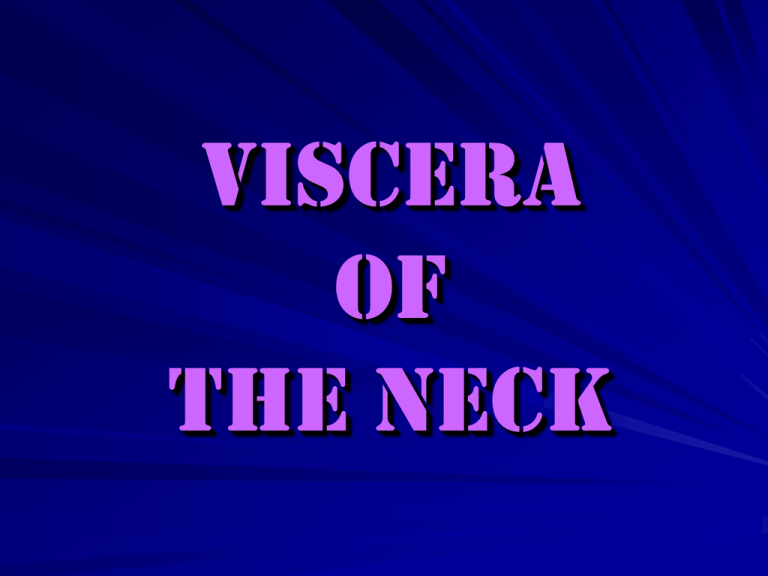
VISCERA OF THE NECK THYROID GLAND OBJECTIVES Definition. Position. Shape. Surfaces and borders. Isthmus. Relations. Blood and lymphatic drainage. Clinical points. Thyroid Gland It is a highly vascular endocrine gland situated in the front of the neck. It is formed of two bear-shaped lobes connected by median isthmus. It is enclosed with the larynx and trachea by the pretracheal fascia so it moves with them during swallowing. Its apex extends upward to the oblique line of the thyroid cartilage, and its base reaches down to the 4-5 tracheal ring. It isthmus extends across the midline in front of the 2nd, 3rd and 4th tracheal rings. A pyramidal lobe may be present. Relations Anterolateral (superficial): – Skin, superficial fascia containing platysma, transverse cervical nerve & anterior jugular vein, investing deep fascia, sternomastoid, sternohyoid and omohyoid (enclosed in pretracheal fascia). Posterolateral (posterior): – Carotid sheath containing common carotid artery, internal jugular vein and vagus nerve. Medial: – Larynx, pharynx, cricothyroid muscle and external laryngeal nerve (above). – Tracheal, esophagus and recurrent laryngeal nerve (below). Blood supply and lymph drainage Arterial blood supply: 1. Superior thyroid artery from external carotid artery. 2. Inferior thyroid artery from thyrocervical trunk from 1st part of subclavian artery. 3. Thyroidea ima artery from brachiocephalic or arch of aorta. Venous drainage: 1. Superior thyroid vein to internal jugular vein. 2. Middle thyroid vein to internal jugular vein. 3. Inferior thyroid veins to left brachiocephalic vein. Lymph drainage: 1. Deep cervical lymph nodes. 2. Paratracheal lymph nodes. Clinical points of thyroid gland Movement of the gland: – The gland moves upward during deglutition (swallowing) because it is enclosed within the pretracheal fascia. Goitre: – Means enlargement of the size of the gland. – It can not extend upward, but it can extend downward and may be retrosternal. – It may compress the trachea. Thyroidectomy: – Means surgical removal of the thyroid gland. – Because the close relationship between the gland and the laryngeal nerves (external and recurrent), they may be damaged during the operation. – Parathyroid gland may be also removed in total thyroidectomy operations. Trachea It is a mobile cartilaginous and membranous respiratory tube. It begins at the lower border of cricoid cartilage (at the level of the 6th cervical vertebra) as a continuation of the larynx. It ends at the sternal angle (between 4th and 5th thoracic vertebrae) by dividing into right and left main bronchi. Relations of Trachea Anterior: – Skin, superficial fascia, investing deep fascia, pretracheal fascia, isthmus of thyroid gland, jugular arch, thyroidea ima artery, sternothyroid and sternohyoid muscles. Posterior: – Right and left recurrent laryngeal nerves, esophagus and vertebral column. Lateral: – Lobes of thyroid gland and carotid sheath (with its contents). Esophagus It is a muscular tube (10 inches long). It begins at the lower border of cricoid cartilage (at the level of the 6th cervical vertebra) as a continuation of the pharynx. It ends in the abdomen by opening into the stomach. At its beginning, it lies in the midline but as it descends in the neck, it inclines to the left side. Relations of Esophagus Anterior: – Trachea and recurrent laryngeal nerves. Posterior: – Prevertebral fascia, longus coli and vertebral column. Lateral: – Lobes of thyroid gland and carotid sheath (with its contents). Arterial supply in the neck: –Branches from inferior thyroid artery. Lymph drainage in the neck: –Deep cervical lymph nodes. Nerve supply in the neck: –From recurrent laryngeal and sympathetic trunk.


